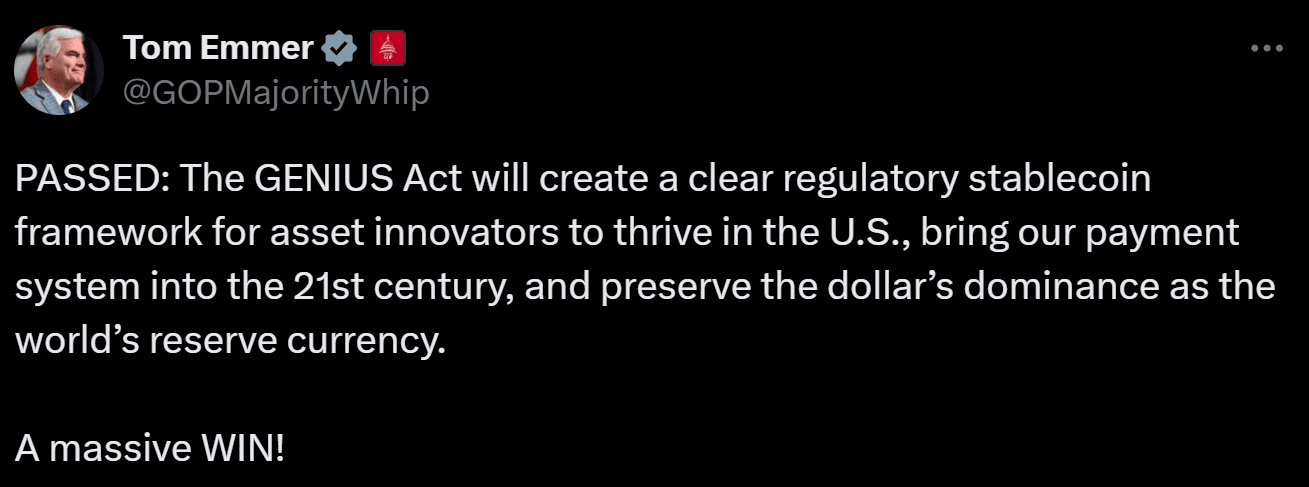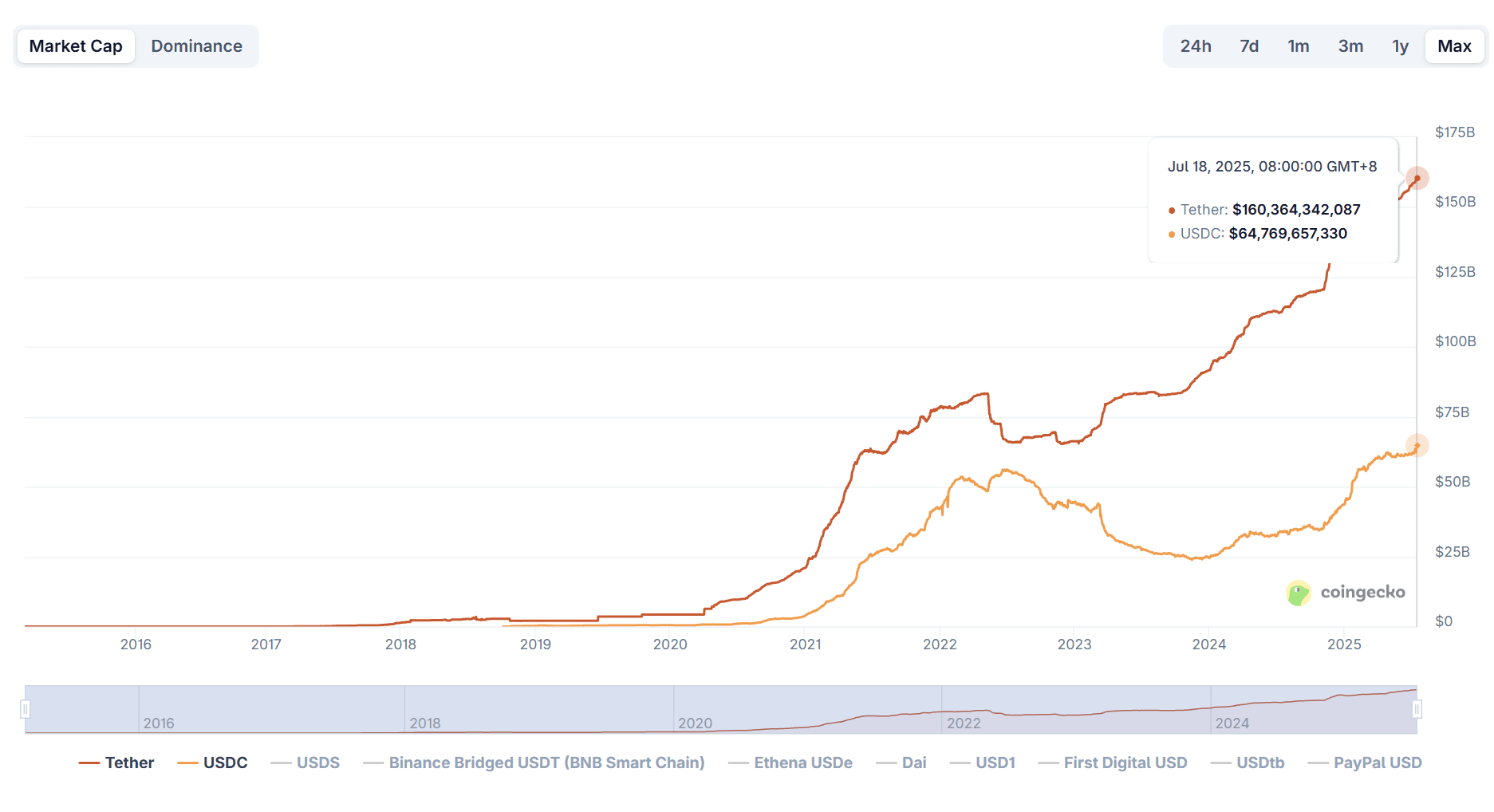Written by: imToken
In the early hours of today, Beijing time, the U.S. House of Representatives passed three crypto-related legislations (the CLARITY Act), (the GENIUS Act), and (the Anti-CBDC Surveillance National Act), among which the (GENIUS Act) is expected to be signed into law by Trump on Friday local time.

This not only marks the first time the U.S. has established a national-level regulatory framework for stablecoins but also sends a clear signal that stablecoins are moving out of the gray area and into the margins of the mainstream financial system. At the same time, major financial centers such as Hong Kong and the European Union are also accelerating their pace, and the global stablecoin landscape is undergoing a reshaping.
Looking back over the past few months, we find that stablecoins have almost overnight transformed from financial variables under regulatory scrutiny into officially recognized new infrastructure. What has happened behind this shift, who is driving stablecoins to become new protagonists on the global financial stage? How should we rationally understand this wave?
From Web3 narratives to national strategies, who is driving this?
From the beginning of the year to now, stablecoins have undoubtedly risen to become the focus of global financial policy and narrative.
However, this wave is not accidental, nor is it a product of natural technological evolution, but rather a structural shift driven by policy forces, especially the policy shift during the Trump era, playing a significant disruptive role.
On one hand, Trump has consistently opposed Central Bank Digital Currency (CBDC) and clearly expressed support for a market-led digital dollar route; on the other hand, from the launch of USD1 by the family business he endorsed to promoting and about to sign the GENIUS Act, Trump is also actively fulfilling his campaign promise to loosen regulations on the crypto market.
This series of signals is also directly forcing global regulatory agencies to re-examine stablecoins. Thus, within just a few months, stablecoins have risen from a marginal topic in the crypto circle to a key point of discussion at the national strategic level. Besides Hong Kong finalizing the timeline for the 'stablecoin regulation', major global economies have begun to seriously consider and accelerate the establishment of clear compliance frameworks for stablecoins.
The (MiCA Regulation) (Markets in Crypto-Assets), effective in the EU in 2024, has comprehensively covered the compliance regulation of crypto assets and detailed the classification of stablecoins.
The ruling party of South Korea, led by new president Lee Jae-myung, has proposed the (Basic Law on Digital Assets), clearly stating that as long as a Korean company has a capital of at least 500 million KRW (approximately 370,000 USD) and ensures refunds through reserves, it can issue stablecoins.
Objectively speaking, the passage of the GENIUS Act is not only a loosening of regulations on stablecoins by the United States but also a clear choice for the digital dollar route — abandoning Central Bank Digital Currency (CBDC) while supporting compliant, privately issued dollar stablecoins.
It is foreseeable that this statement from the U.S. will become a reference paradigm for regulatory design in other countries, promoting the entry of stablecoins into the universal discussion framework of global financial policy.
The path of stablecoins is changing
In recent years, the stablecoin market has long been dominated by Tether (USDT) and Circle (USDC), representing two paths of 'circulation efficiency' and 'compliance transparency':
USDT focuses on cross-platform circulation and matching efficiency, dominating in exchanges and gray settlement networks.
USDC emphasizes asset compliance and transparency, deeply cultivating regulatory-friendly scenarios and an institutional client system;
From an overall scale perspective, since 2025, stablecoins have maintained a growth trend — according to CoinGecko data, as of July 18, the total market cap of stablecoins across the network is approximately 262 billion USD, an increase of over 20% compared to the beginning of the year.

This also means that during the recovery of the crypto market, stablecoins remain the core 'liquidity entry point', with the duopoly of USDT and USDC still solid — USDT's total market cap exceeds 160 billion USD, accounting for over 60%; USDC remains around 65 billion USD, accounting for about 25%, with a combined share of nearly 90%.
Starting in 2024, more and more Web2 financial enterprises and traditional financial forces are beginning to enter the market, using stablecoins to build on-chain settlement tools, such as PayPal's PYUSD and the newly politically capital-backed USD1, which are two representative signals.
PYUSD (PayPal USD) was launched by the payment giant PayPal, naturally equipped with cross-border settlement scenarios and a global merchant network; USD1 aims to facilitate compliant on-chain deposits and withdrawals as well as cross-border business, supported by political and business resources endorsed by Trump, entering corporate settlement scenarios.
It can be said that with the support of institutions and national forces, these emerging stablecoin projects are driving the function of stablecoins from 'Web3 liquidity tools' to a value bridge connecting Web3 and the real economic system, with their use cases gradually penetrating into supply chain finance, cross-border trade, freelancer settlements, OTC scenarios, and other diverse applications.
Behind the frenzy, where is the real challenge for stablecoins?
However, objectively speaking, while the GENIUS Act has granted institutional recognition to stablecoins, it has also brought more compliance requirements, setting clearer boundary rules for their development.
For example, issuers must comply with KYC/AML management, funds need to have custody isolation and third-party audits, and in extreme cases, issuance limits or usage restrictions may be set, which means stablecoins have gained legal status but have also officially entered the 'regulated currency role'.
From this perspective, whether stablecoins can break through the application limitations of Web3 in the future is key to achieving incremental landing, as the greatest growth potential of stablecoins lies not within the Crypto internal circle but in the broader Web2 and the global real economy.
Just like the main growth of USDT and USDC has not come from on-chain interactive users, but rather from small and medium-sized enterprises and individual merchants with a strong demand for cross-border settlement, emerging markets and financially disadvantaged areas unable to access the SWIFT network, residents of inflation-hit countries eager to escape local currency fluctuations, and content creators and freelancers who cannot use PayPal or Stripe.
In other words, its future growth will not be in Web3 but in Web2 — the real killer application of stablecoins is not 'the next DeFi protocol', but 'replacing traditional dollar accounts'.
This also means that once stablecoins become the foundational carriers of the digital dollar globally, they will inevitably touch upon sensitive nerves such as monetary sovereignty, financial sanctions, and geopolitical order.
Therefore, the next stage of growth for stablecoins will inevitably be closely related to the new landscape of dollar globalization, becoming a new battleground among governments, international institutions, and financial giants.
In conclusion
The essence of currency issuance has always been an extension of power, relying not only on asset reserves and settlement efficiency but also on national credit, regulatory approval, and international status endorsements.
Stablecoins are no exception; if they truly want to penetrate the real economic system from the Crypto world, relying solely on market mechanisms or business logic is ultimately insufficient. Therefore, the compliance assistance brought by the global policy shift in 2025 is certainly an important driver for stablecoins to go mainstream, but it also means they must survive in a more complex game.
This is a long-term game, and we are currently at the stage where it truly begins.


